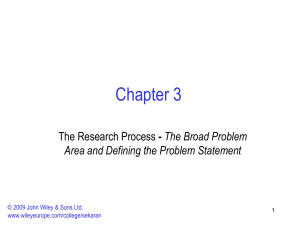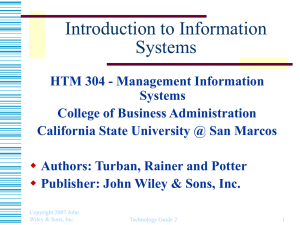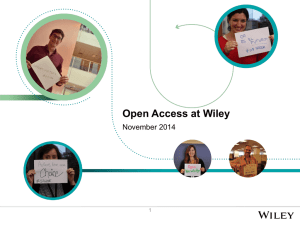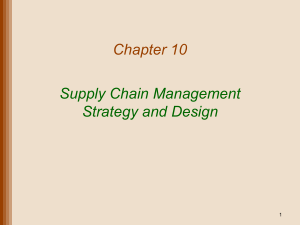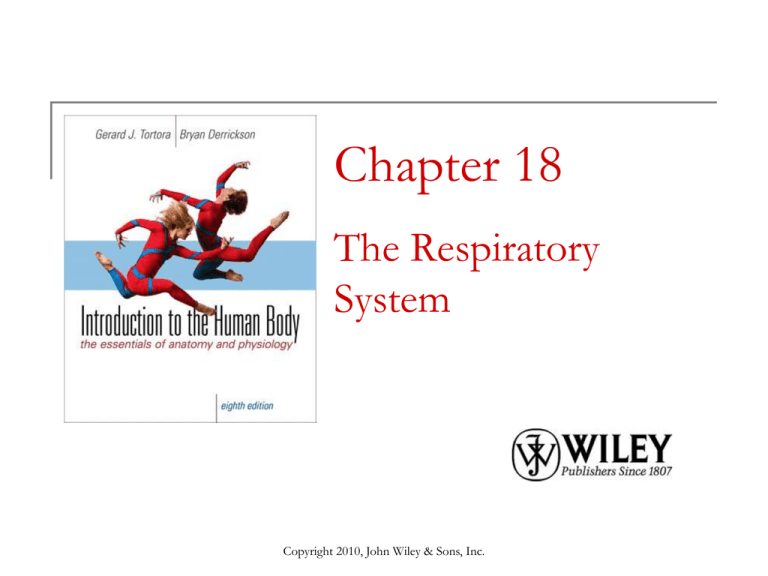
Chapter 18
The Respiratory
System
Copyright 2010, John Wiley & Sons, Inc.
Respiration: Three Major Steps
1. Pulmonary ventilation
Moving air in and out of lungs
2. External respiration
Gas exchange between alveoli and blood
3. Internal respiration
Gas exchange between blood and cells
Copyright 2010, John Wiley & Sons, Inc.
Organs of the Respiratory System
Upper respiratory system
Lower respiratory system
Nose and pharynx
Trachea, larynx, bronchi, bronchioles, and lungs
“Conducting zone” consists of
All airways that carry air to lungs:
Nose, pharynx, trachea, larynx, bronchi, bronchioles,
and terminal bronchioles
“Respiratory zone”
Sites within lungs where gas exchange occurs
Respiratory bronchioles, alveolar ducts, alveolar sacs,
and alveoli
Copyright 2010, John Wiley & Sons, Inc.
Organs of the Respiratory System
Copyright 2010, John Wiley & Sons, Inc.
Upper Respiratory System: Nose
Structure
External nares nasal cavity internal nares
Nasal septum divides nose into two sides
Nasal conchae covered by mucous membrane
Functions
Warm, humidify, filter/trap dust and microbes
Mucus and cilia of epithelial cells lining nose
Detect olfactory stimuli
Modify vocal sounds
Copyright 2010, John Wiley & Sons, Inc.
Upper Respiratory System: Pharynx
Known as the “throat”
Structure
Funnel-shaped tube from internal nares to larynx
3 parts
Three regions (with tonsils in the upper two)
Upper: nasopharynx; posterior to nose
Middle: oropharynx; posterior to mouth
Adenoids and openings of auditory (Eustachian) tubes
Palatine and lingual tonsils are here
Lower: laryngeal pharynx
Connects with both esophagus and larynx: food and air
Copyright 2010, John Wiley & Sons, Inc.
Respiratory System: Head and Neck
Copyright 2010, John Wiley & Sons, Inc.
Lower Respiratory System: Larynx
“Voice box”
Made largely of cartilage
Thyroid cartilage: V-shaped
Epiglottis: leaf-shaped piece; covers airway
“Adam's apple”: projects more anteriorly in males
Vocal cords “strung” here (and to arytenoids)
During swallowing, larynx moves up so epiglottis covers
opening into trachea
Cricoid cartilage: inferior most portion
Arytenoids (paired, small) superior to cricoid
Copyright 2010, John Wiley & Sons, Inc.
Lower Respiratory System: Larynx
Copyright 2010, John Wiley & Sons, Inc.
Voice Production
Mucous membrane of larynx forms two pairs
of folds
Upper = false vocal cords
Lower = true vocal cords
Contain elastic ligaments
When muscles pull elastic ligaments tight, vocal
cords vibrate sounds in upper airways
Pitch adjusted by tension of true vocal cords
Lower pitch of male voice
Vocal cords longer and thicker; vibrate more
slowly
Copyright 2010, John Wiley & Sons, Inc.
Lower Respiratory System: Trachea
“Windpipe”
Location
Structure
Anterior to esophagus and thoracic vertebrae
Extends from end of larynx to primary bronchi
Lined with pseudostratified ciliated mucous
membrane: traps and moves dust upward
C-shaped rings of cartilage support trachea, keep
lumen open during exhalation
Tracheostomy: opening in trachea for tube
Copyright 2010, John Wiley & Sons, Inc.
Lower Respiratory System: Bronchi,
Bronchioles
Structure of bronchial tree
Bronchi contain cartilage rings
Primary bronchi enter the lungs medially
In lungs, branching secondary bronchi
One for each lobe of lung: 3 in right, 2 in left
Tertiary bronchi terminal bronchioles
These smaller airways
Have less cartilage, more smooth muscle. In
asthma, these airways can close.
Can be bronchodilated by sympathetic nerves,
epinephrine, or related medications.
Copyright 2010, John Wiley & Sons, Inc.
Lower Respiratory System: Lungs
Two lungs: left and right
Right lung has 3 lobes
Left lung has 2 lobes and cardiac notch
Lungs surrounded by pleural membrane
Parietal pleura attached to diaphragm and lining
thoracic wall
Visceral pleura attached to lungs
Pleural cavity with little fluid between pleurae
Broad bottom of lungs = base; pointy top = apex
Copyright 2010, John Wiley & Sons, Inc.
Lung Lobes
Divided into lobules fed by tertiary bronchi
Further divisions terminal bronchioles
Respiratory bronchioles
Lined with nonciliated epithelium
Alveolar ducts
Alveolar sacs
Surrounded by alveoli
Copyright 2010, John Wiley & Sons, Inc.
Lung Lobes
Copyright 2010, John Wiley & Sons, Inc.
Lower Respiratory System: Alveoli
Cup-shaped outpouchings of alveolar sacs
Alveoli: composed of three types of cells
Lined with thin alveolar cells (simple squamous);
sites of gas exchange
Scattered surfactant-secreting cells. Surfactant:
Lowers surface tension (keeps alveoli from collapsing)
Humidifies (keeps alveoli from drying out)
Alveolar macrophages: “cleaners”
Respiratory membrane: alveoli + capillary
Gases diffuse across these thin epithelial layers:
air blood
Copyright 2010, John Wiley & Sons, Inc.
Lobule of the Lung
Copyright 2010, John Wiley & Sons, Inc.
Lobule of the Lung
Copyright 2010, John Wiley & Sons, Inc.
Structure of an Alveolus
Copyright 2010, John Wiley & Sons, Inc.
Respiration Step: 1. Pulmonary Ventilation
Air flows: atmosphere lungs due to
difference in pressure related to lung volume
Inhalation: diaphragm + external intercostals
Lung volume changes due to respiratory muscles
Diaphragm contracts (moves downward) lung
volume
Cohesion between parietal-visceral pleura
lung volume as thorax volume .
Copyright 2010, John Wiley & Sons, Inc.
Exhalation
Exhalation is normally passive process due to
muscle relaxation
Diaphragm relaxes and rises lung volume
External intercostals relax lung volume
Active exhalation: exhale forcefully
Example: playing wind instrument
Uses additional muscles: internal intercostals,
abdominal muscles
Copyright 2010, John Wiley & Sons, Inc.
Muscles of Inhalation and Exhalation
Copyright 2010, John Wiley & Sons, Inc.
Muscles of Inhalation and Exhalation
Copyright 2010, John Wiley & Sons, Inc.
Volume-Pressure Changes in Lungs
Volume and pressure are inversely related
As lung volume alveolar pressure
As lung volume alveolar pressure
Contraction of diaphragm lowers diaphragm
lung volume alveolar pressure so it is <
atmospheric pressure air enters lungs =
inhalation
Relaxation of diaphragm raises diaphragm
lung volume alveolar pressure so it is >
atmospheric pressure air leaves lungs =
exhalation
Copyright 2010, John Wiley & Sons, Inc.
Volume-Pressure Changes in Lungs
Copyright 2010, John Wiley & Sons, Inc.
Air Flow Terms
Frequency = breaths/min; normal: 12
Tidal volume (TV) = volume moved in one
breath. Normal ~ 500 ml
About 70% of TV reaches alveoli (350 ml)
Only this amount is involved in gas exchange
30% in airways = anatomic dead space
Minute ventilation (MV) = f x TV = 6000
mL/min
Copyright 2010, John Wiley & Sons, Inc.
Lung Volumes
Measured by spirometer
Inspiratory reserve volume (ERV) = volume of air
that can be inhaled beyond tidal volume (TV)
Expiratory reserve volume (IRV) = volume of air
that can be exhaled beyond TV
Air remaining in lungs after a maximum expiration
= residual volume (RV)
Copyright 2010, John Wiley & Sons, Inc.
Lung Capacities
Inspiratory capacity = TV + IRV
Functional residual capacity (FRC) =
RV + ERV
Vital capacity (VC) = IRV + TV + ERV
Total lung capacity (TLC) = VC + RV
Copyright 2010, John Wiley & Sons, Inc.
Lung Capacities
Copyright 2010, John Wiley & Sons, Inc.
Breathing Patterns
Eupnea = normal breathing
Highly variable in pattern
Costal breathing: shallow with rib movements
Diaphragmatic breathing: deep breathing
Special modifications for speech and
emotional responses
Also variations for coughing and sneezing to
clear airways
See Table 18.1
Copyright 2010, John Wiley & Sons, Inc.
Nature of Air
Mixture of gases (N2, O2,, CO2, H2O, and
others)
Each gas has own partial pressure, such as
PO2 or PN2
Sum of all partial pressures = atmospheric
pressure
Each gas diffuses down its partial pressure
gradient
Copyright 2010, John Wiley & Sons, Inc.
Respiration Step 2: Pulmonary Gas
Exchange: External Respiration
Diffusion across alveolar-capillary membrane
O2 diffuses from air (PO2 ~105 mm Hg) to
pulmonary artery (“blue”) blood (PO2 ~40 mm Hg).
(Partial pressure gradient = 65 mm Hg)
Continues until equilibrium (PO2 ~100-105 mm Hg)
Meanwhile “blue” blood (PCO2 ~45) diffuses to
alveolar air (PCO2 ~40) (Partial pressure gradient =
5 mm Hg)
Copyright 2010, John Wiley & Sons, Inc.
Respiration Step 3: Systemic Gas Exchange:
Internal Respiration
Occurs throughout body
O2 diffuses from blood to cells: down partial
pressure gradient
PO2 lower in cells than in blood because O2
used in cellular metabolism
Meanwhile CO2 diffuses in opposite direction:
cells blood
Copyright 2010, John Wiley & Sons, Inc.
Internal and
External
Respiration
Copyright 2010, John Wiley & Sons, Inc.
Transport of Oxygen within Blood
98.5% of O2 is transported bound to
hemoglobin in RBCs
Binding depends on PO2
High PO2 in lung and lower in tissues
O2 dissolves poorly in plasma so only 1.5% is
transported in plasma
Tissue release of O2 to cells is increased by
factors present during exercise:
High CO2 (from active muscles)
Acidity (lactic acid from active muscles)
Higher temperatures (during exercise)
Copyright 2010, John Wiley & Sons, Inc.
Transport of Carbon Dioxide
CO2 diffuses from tissues into blood
CO2 carried in blood:
Some dissolved in plasma (7%)
Bound to proteins including hemoglobin (23%)
Mostly as part of bicarbonate ions (70%)
CO2 + H2O H+ + HCO3-
Process reverses in lungs as CO2 diffuses
from blood into alveolar air exhaled
Copyright 2010, John Wiley & Sons, Inc.
Transport of
Oxygen and
Carbon Dioxide
Copyright 2010, John Wiley & Sons, Inc.
Control of Respiration
Medullary rhythmicity area in medulla
Quiet breathing
Contains both inspiratory and expiratory areas
Inspiratory area nerve signals to inspiratory
muscles for ~2 sec
Inspiration
Inspiration ends and muscles relax
Expiration
Expiratory center active only during forceful
breathing
Two areas in pons adjust length of inspiratory
stimulation
Copyright 2010, John Wiley & Sons, Inc.
Control of Respiration
Copyright 2010, John Wiley & Sons, Inc.
Control of Respiration
Copyright 2010, John Wiley & Sons, Inc.
Regulation of Respiratory Center
Cortical input: voluntary adjustment of
patterns
For talking or cessation of breathing while
swimming
Chemoreceptor input will override breath-holding
Copyright 2010, John Wiley & Sons, Inc.
Regulation of Respiratory Center
Chemoreceptor input to increase
ventilation
Central receptors in medulla: sensitive to H+ or
PCO2
in CSF
Peripheral receptors in arch of aorta + common
carotids: respond to PO2 as well as H+ or
PCO2 in blood
Blood and brain pH can be maintained by
these negative feedback mechanisms
Copyright 2010, John Wiley & Sons, Inc.
Regulation of
Respiratory Center
Copyright 2010, John Wiley & Sons, Inc.
Other Regulatory Factors of Respiration
Respiration can be stimulated by
Sudden pain can apnea: stop breathing
Limbic system: anticipation of activity, emotion
Proprioception as activity is started
Increase of body temperature
Prolonged somatic pain can increase rate
Airway irritation cough or sneeze
Inflation reflex
Bronchi wall stretch receptors inhibit inspiration
Prevents overinflation
Copyright 2010, John Wiley & Sons, Inc.
Aging and the Respiratory System
Lungs lose elasticity/ability to recoil more
rigid; leads to
Decrease in vital capacity
Decreased blood PO2 level
Decreased exercise capacity
Decreased macrophage activity and ciliary
action
Increased susceptibility to pneumonia, bronchitis
and other disorders
Copyright 2010, John Wiley & Sons, Inc.
End of Chapter 18
Copyright 2010 John Wiley & Sons, Inc.
All rights reserved. Reproduction or translation of
this work beyond that permitted in section 117 of the
1976 United States Copyright Act without express
permission of the copyright owner is unlawful.
Request for further information should be addressed
to the Permission Department, John Wiley & Sons,
Inc. The purchaser may make back-up copies for
his/her own use only and not for distribution or
resale. The Publishers assumes no responsibility
for errors, omissions, or damages caused by the use
of theses programs or from the use of the
information herein.
Copyright 2010, John Wiley & Sons, Inc.


